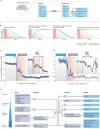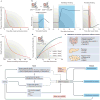Neural circuits underlying thirst and fluid homeostasis
- PMID: 28638120
- PMCID: PMC5955721
- DOI: 10.1038/nrn.2017.71
Neural circuits underlying thirst and fluid homeostasis
Abstract
Thirst motivates animals to find and consume water. More than 40 years ago, a set of interconnected brain structures known as the lamina terminalis was shown to govern thirst. However, owing to the anatomical complexity of these brain regions, the structure and dynamics of their underlying neural circuitry have remained obscure. Recently, the emergence of new tools for neural recording and manipulation has reinvigorated the study of this circuit and prompted re-examination of longstanding questions about the neural origins of thirst. Here, we review these advances, discuss what they teach us about the control of drinking behaviour and outline the key questions that remain unanswered.
Figures



References
-
- Cannon WB. The physiological basis of thirst. Proceedings of the Royal Society B: Biological Sciences. 1918;90:283–301.
-
- Montgomery MF. The role of the salivary glands in the thirst mechanism. American Journal of Physiology. 1931;96:221–227.
-
- Leschke E. Ueber die durstempfindung. Archiv für Psychiatrie & Nervenkrankheiten. 1918;59:773–781.
-
- Gilman A. The relation between blood osmotic pressure, fluid distribution and voluntary water intake. American Journal of Physiology. 1937;120:323–328.
-
- Wolf AV. Osmometric analysis of thirst in man and dog. American Journal of Physiology. 1950;161:75–86. - PubMed
Publication types
MeSH terms
Grants and funding
LinkOut - more resources
Full Text Sources
Other Literature Sources

